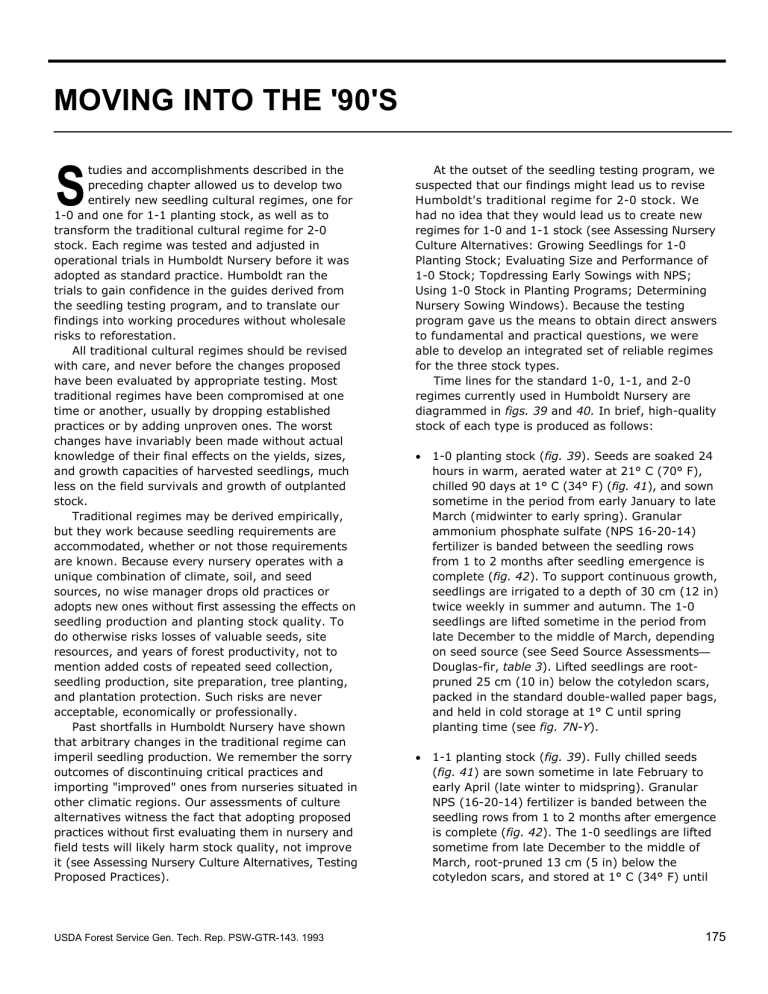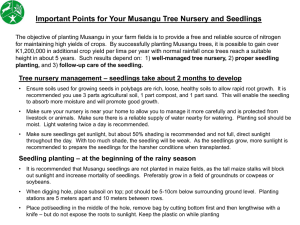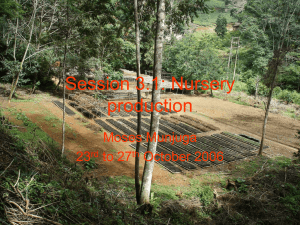S MOVING INTO THE '90'S

MOVING INTO THE '90'S
S tudies and accomplishments described in the preceding chapter allowed us to develop two entirely new seedling cultural regimes, one for
1-0 and one for 1-1 planting stock, as well as to transform the traditional cultural regime for 2-0 stock. Each regime was tested and adjusted in operational trials in Humboldt Nursery before it was adopted as standard practice. Humboldt ran the trials to gain confidence in the guides derived from the seedling testing program, and to translate our findings into working procedures without wholesale risks to reforestation.
All traditional cultural regimes should be revised with care, and never before the changes proposed have been evaluated by appropriate testing. Most traditional regimes have been compromised at one time or another, usually by dropping established practices or by adding unproven ones. The worst changes have invariably been made without actual knowledge of their final effects on the yields, sizes, and growth capacities of harvested seedlings, much less on the field survivals and growth of outplanted stock.
Traditional regimes may be derived empirically, but they work because seedling requirements are accommodated, whether or not those requirements are known. Because every nursery operates with a unique combination of climate, soil, and seed sources, no wise manager drops old practices or adopts new ones without first assessing the effects on seedling production and planting stock quality. To do otherwise risks losses of valuable seeds, site resources, and years of forest productivity, not to mention added costs of repeated seed collection, seedling production, site preparation, tree planting, and plantation protection. Such risks are never acceptable, economically or professionally.
Past shortfalls in Humboldt Nursery have shown that arbitrary changes in the traditional regime can imperil seedling production. We remember the sorry outcomes of discontinuing critical practices and importing "improved" ones from nurseries situated in other climatic regions. Our assessments of culture alternatives witness the fact that adopting proposed practices without first evaluating them in nursery and field tests will likely harm stock quality, not improve it (see Assessing Nursery Culture Alternatives, Testing
Proposed Practices).
At the outset of the seedling testing program, we suspected that our findings might lead us to revise
Humboldt's traditional regime for 2-0 stock. We had no idea that they would lead us to create new regimes for 1-0 and 1-1 stock (see Assessing Nursery
Culture Alternatives: Growing Seedlings for 1-0
Planting Stock; Evaluating Size and Performance of
1-0 Stock; Topdressing Early Sowings with NPS;
Using 1-0 Stock in Planting Programs; Determining
Nursery Sowing Windows). Because the testing program gave us the means to obtain direct answers to fundamental and practical questions, we were able to develop an integrated set of reliable regimes for the three stock types.
Time lines for the standard 1-0, 1-1, and 2-0 regimes currently used in Humboldt Nursery are diagrammed in figs. 39 and 40. In brief, high-quality stock of each type is produced as follows:
• 1-0 planting stock (fig. 39). Seeds are soaked 24 hours in warm, aerated water at 21° C (70° F), chilled 90 days at 1° C (34° F) (fig. 41), and sown sometime in the period from early January to late
March (midwinter to early spring). Granular ammonium phosphate sulfate (NPS 16-20-14) fertilizer is banded between the seedling rows from 1 to 2 months after seedling emergence is complete (fig. 42). To support continuous growth, seedlings are irrigated to a depth of 30 cm (12 in) twice weekly in summer and autumn. The 1-0 seedlings are lifted sometime in the period from late December to the middle of March, depending on seed source (see Seed Source Assessments
—
Douglas-fir, table 3). Lifted seedlings are rootpruned 25 cm (10 in) below the cotyledon scars, packed in the standard double-walled paper bags, and held in cold storage at 1° C until spring planting time (see fig. 7N-Y).
• 1-1 planting stock (fig. 39). Fully chilled seeds
(fig. 41) are sown sometime in late February to early April (late winter to midspring). Granular
NPS (16-20-14) fertilizer is banded between the seedling rows from 1 to 2 months after emergence is complete (fig. 42). The 1-0 seedlings are lifted sometime from late December to the middle of
March, root-pruned 13 cm (5 in) below the cotyledon scars, and stored at 1° C (34° F) until
175 USDA Forest Service Gen. Tech. Rep. PSW-GTR-143. 1993
Cultural Regime for 1-0 and 1-1 Douglas-fir
Figure 39— Seedling cultural regime for producing 1-0 and 1-1 Douglas-fir in Humboldt Nursery. Seeds are chilled 90 days and sown in January-March ( fig. 41 ).
Granular ammonium phosphate sulfate (NPS 16-20-14) is banded 1 inch (2.5 cm) deep between the seedling rows in April-May, to supply 100 lb N per acre (112 kg N per ha) 1 to 2 months after seedling emergence ( fig. 42 ).
The 1-0 seedlings are lifted in late December to late
March, within known seed source lifting windows (see
Seed Source Assessments—Douglas-fir, table 3 ).
Seedlings for 1-0 planting stock are graded to a stem diameter of 0.1 inch (2.5 mm), root-pruned at 9 inches
(23 cm) below the cotyledon node, and stored at 1° C
(34° F) for spring planting in the seed zones of origin
(see fig. 7 ).
Seedlings for 1-1 stock are root-pruned at 5 inches
(13 cm) below the cotyledon node, stored at 1° C, and machine-planted in the nursery in January to July ( fig.
43 ). The transplants are banded with NPS in March to
August, to supply 100 lb N per acre about 2 weeks after they start root elongation ( fig. 42 ).
The 1-1 seedlings are lifted in early December to late
March, within known source lifting windows (see Seed
Source Assessments—Douglas-fir, table 3 ). They are graded to a stem diameter of 0.18 inch (4.5 mm), rootpruned at 10 inches (25 cm) below the ground line, and stored at 1° C for spring planting in the seed zones of origin (see fig. 7N-Y ).
176 transplanted for a second growing season in the nursery. Stored seedlings are transplanted from
January to April to produce large 1-1 stock, or from May to August to produce progressively smaller 1-1 stock (fig. 43). Granular NPS is banded between the transplant rows after root elongation is underway. The 1-1 seedlings are lifted sometime from late November to the middle of March, depending on seed source (see Seed
Source Assessments
—
Douglas-fir, table 3). Lifted seedlings are root-pruned 25 cm (10 in) below the ground line, packed in the standard or larger bags, and stored at 1° C until spring planting time (see
fig. 7N-Y) .
• 2-0 planting stock (fig. 40). Fully chilled seeds
(fig. 41) are sown sometime in February to early
April (late winter to midspring). Granular NPS
(16-20-14) fertilizer is banded between the seedling rows from 1 to 2 months after emergence is complete (fig. 42). The 1-0 seedlings are held in place for a second growing season in the nursery, but if necessary could be lifted for 1-0 stock or transplanted for 1-1 stock. Granular NPS is banded between the seedling rows just before or after root elongation resumes in March (fig. 42).
To increase root mass and reduce top growth, second-year seedlings are undercut twice in spring, in March at a depth of 13 cm (5 in) and in
May at a depth of 18 cm (7 in). Root systems are vertically pruned to a depth of 10 cm (4 in) between the seedling rows in April. The 2-0 seedlings are lifted sometime from late November to the middle of March, depending on seed source
(see Seed Source Assessments
—
Douglas-fir, table
3). Lifted seedlings are root-pruned 25 cm (10 in) below the ground line, packed in the standard or larger bags, and stored at 1° C (34° F) until spring planting time (see fig. 7N-Y).
Transplanting 1-0 seedlings for 1-1 stock rather than holding them in place for 2-0 stock vastly improves seedling yield, balance, and quality, and is preferred practice at Humboldt Nursery. Experience has consistently shown that transplanting seedlings to a spacing of 6 to 8 per square foot (65 to 86 per m 2 ) results in greater and more uniform radial growth and yields 1-1 stock with cull rates as low as 1 to 5 percent. Moreover, 1-1 stock size, height, and toproot ratio can be markedly reduced by delaying transplanting until summer. Transplanting in April,
May, June, July, and August yields 1-1 stock with progressively shorter tops and lower top-root ratios
(Nelson and Jenkinson 1992).
USDA Forest Service Gen. Tech. Rep. PSW-GTR-143. 1993
Cultural Regime for 2-0 Douglas-fir
Figure 40— Seedling cultural regime for producing 2-0
Douglas-fir and other conifers in Humboldt Nursery.
Seeds are chilled 90 days and sown in February to early
April ( fig. 41 ). Granular ammonium phosphate sulfate
(NPS 16-20-14) is banded 1 inch (2.5 cm) deep between the seedling rows in April-May, to supply 100 lb N per acre (112 kg N per ha) 1 to 2 months after seedling emergence, and again the following March, when root elongation resumes ( fig. 42 ).
To develop fibrous root systems, control height growth, and secure balanced planting stock, the secondyear seedlings are double-undercut in spring, at 5 inches
(13 cm) in March and 7 inches (18 cm) in May, once before budburst and once after shoot extension is well underway. Roots between the seedling rows are vertically pruned to a depth of 4 inches (10 cm) in April, about 1 month after the first undercut.
The 2-0 seedlings are lifted in December to late
March, within known seed source lifting windows (see
Seed Source Assessments—Douglas-fir, table 3 , and
Seed Source Assessments—Other Conifers, table 9 ).
They are graded to a stem diameter of 0.18 inch (4.5 mm), root-pruned at 10 inches (25 cm) below the ground line, and stored at 1° C (34° F) for spring planting in the seed zones of origin (see fig. 7N-Y ).
USDA Forest Service Gen. Tech. Rep. PSW-GTR-143. 1993
By contrast, holding early-sow 1-0 seedlings in place for 2-0 stock can result in highly variable radial growth and yield 1-1 stock with cull rates of
25 to 35 percent, depending on seed source, sowing date, and seedling stocking (see Assessing Nursery
Culture Alternatives: Carrying 1-0 for 2-0 Planting
Stock, and Undercutting Early Sowings for 2-0
Stock). Besides being inherently inefficient, the 2-0 regime is difficult to manage for balanced stock.
Successful control of seedling height and top-root ratio is critical, and is easily and reliably achieved by using the 1-0 and 1-1 regimes.
Foresters sometimes change their planting plans, or have them changed by events beyond their control, and necessarily have their planting stock held in the nursery for another growing season, to save it for outplanting the next year. Experience has shown that holding large 1-0 seedlings in place has major disadvantages for both the nursery and clientele. Holding seedlings in place results in unavoidably high cull rates, compromises the culture of seedlings growing in adjacent beds, and disrupts the crop rotation and soil management plans. To guarantee the size, balance, quantity, and quality of stock desired, clients should permit Humboldt to transplant all of their holdover 1-0 for 1-1 stock, rather than save it as 2-0 stock.
Nursery experience has repeatedly shown that all
2-0 seedlings, both holdover and returned stock, can be transplanted anytime from April to July and saved successfully for 2-1 stock. Holdover seedlings in the nursery are lifted within the source lifting windows, root-pruned, and held in cold storage for May-June transplanting. To insure balanced 2-1 stock, roots and tops of holdover and returned seedlings are pruned severely. Roots are pruned 13 cm (5 in) below the ground line to prevent root-sweep or Lrooting by the transplant machine, and to promote the development of bushy, fibrous root systems.
Tops are cut back to 25 cm (10 in) to limit new shoot growth and minimize height of the 2-1 stock.
Effective management of seedling cultural regimes in Humboldt Nursery, or in any other forest nursery, depends on knowing how to integrate, schedule, and apply specific practices in ways proven to yield planting stock of high survival and growth potentials.
Seedling testing programs are now and will remain the best way to monitor planting stock quality and assess proposed cultural practices. To the extent possible, Humboldt's current and future regimes for
1-0, 1-1, and 2-0 stock will continue to depend on the hard evidence of survival and growth on cleared planting sites in seed zones of origin, in climates and environments typical of the physiographic regions that Humboldt serves.
177
SEED TREATMENT BEFORE SOWING
A
Transfer seeds to mesh bags
B
Transfer bags to water bath
Figure 41— Standard seed treatment before sowing in Humboldt Nursery.
Seeds are placed in nylon mesh bags (A) and soaked 40 hours at 22° C (72° F) in an aerated water bath until the bags sink below the surface (B, C). Soaked seeds are drained by hanging the bags on racks (A). Drained seeds, loosely enclosed in polybags to keep them moist but allow air exchange, are placed on carts, rolled into a cold room (D), and chilled 90 days at 0-1° C (32-34° F).
After 30 days, seeds are spread on wire screens in a forced-air environment (E), surface-dried 2 to 4 hours to prevent premature germination, and rebagged to complete chilling (D).
C
Soak seeds until bags sink
D
Chill seeds for 90 days
E
Surface-dry seeds at 30 days
178 USDA Forest Service Gen. Tech. Rep. PSW-GTR-143. 1993
Figure 42— Machine used to band granular ammonium phosphate sulfate (NPS) fertilizer between rows of newly emerged seedlings, second-year seedlings, and transplanted 1-0 seedlings in Humboldt Nursery. Granules of NPS are fed from the hoppers to the bed by a bank of flexible hoses mounted behind two gangs of paired colters. The colters are set to cut soil channels 1 inch (2.5 cm) deep.
Figure 43— Machine used to transplant seedlings for 1-1 planting stock in Humboldt Nursery. The 1-0 seedlings are root-pruned 5 inches (13 cm) below the cotyledons just after lifting, held in cold storage, and transplanted into six rows per bed. Transplanting results in a bed density of 6 to 8 stems per square foot (65 to 86 stems per m 2 ).
USDA Forest Service Gen. Tech. Rep. PSW-GTR-143. 1993 179
Douglas-fir plantation at age 22, 4 years after thinning: Fox Ridge unit 11-3, with
Buck Mountain in distance, and closeup of developing stand and understory
180 USDA Forest Service Gen. Tech. Rep. PSW-GTR-143. 1993






